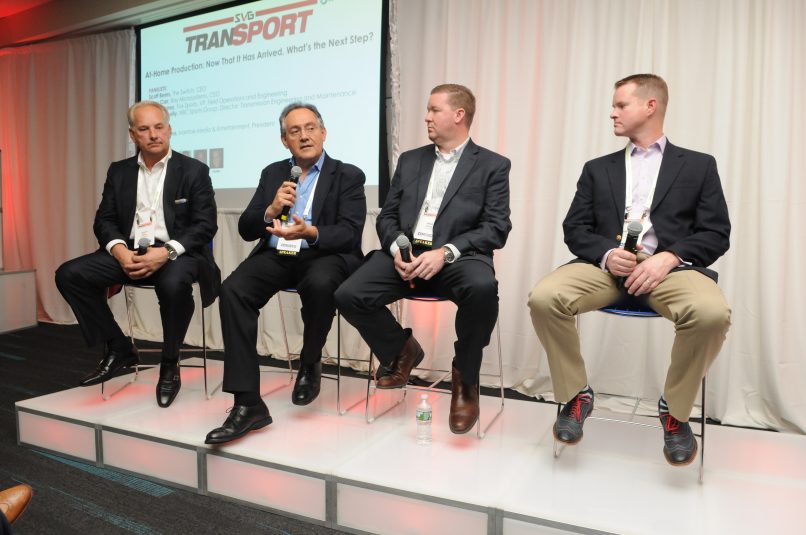SVG TranSPORT: At-Home Productions Will Drive Bandwidth Demand
Story Highlights
Over the past two years, no trend has had a larger impact on the evolution of live sports production than the “at-home” model. And that trend is one of the reasons the topic was an important discussion point at SVG’s TranSPORT last week.
The Switch CEO Scott Beers said his company uses the term home run to describe delivering camera and audio signals from a venue to a remote facility, where they are then produced. The approach provides an opportunity for a company like The Switch, which focuses squarely on making sure those video and audio signals are as of high a quality as possible.

From left: Scott Beers of The Switch, Harry Carr of Bay Microsystems, Brad Cheney of Fox Sports, and Chris Connolly of NBC Sports discussed “at-home” productions during SVG’s TranSPORT conference.
“We aren’t putting banking or phone calls on our network,” he pointed out. “It was built for the industry with tens of millions of dollars and resulted in 700 10-Gbps wave-based circuits.”
Technologies from Netinsight and Nimbra working in conjunction with control software ensure that signals are handled in a robust way and with redundancy because, increasingly, satellite trucks are not used for backup transmission. The Switch also makes sure that the technical setup at each venue is identical, making it easier for production and technical teams to do their jobs.
Bay Microsystems CEO Harry Carr noted that his company’s technology is additive and designed to improve the throughput speed of network traffic.
“One of the key challenges is improving that throughput, and we can get it so that 95% of the available bandwidth is being used, so that it doesn’t matter if the person is sitting in the truck outside the venue or thousands of miles away,” he explained. “If the user can’t access the data and act on it quickly, they lose an opportunity because data is good only if you can get to it, move it, and monetize it. You can have the best cameras in the world, but, if you can’t get the signal, what good is it to you?”
The key, according to Brad Cheney, VP, field operations and engineering, Fox Sports, is finding the right production solution for the right sport at the right time. For example, he noted, Fox Sports has relied on Level 3 circuits for college-basketball coverage, moving live data and content back and forth among three Fox facilities across the country. The workflow has really made a difference for cutting promos, because editors on the road and back at home can be working with the same material and on the same projects with everything in sync. During the World Series, Bay Microsystems helped transfer 37 TB of data between two SANs over a 14-day period.
Much of the buzz has been about the possibility of having a large portion of the production team work out of a fixed facility that brings in audio and video signals via fiber and builds the show. But the economics and workflows are not cut-and-dried: the production will still require plenty of equipment in the field as well as support staff with the right level of expertise.
“That expertise is hard to build from within,” noted Cheney. “So we end up being better off renting from our normal partners because they provide a level of protection and expertise.”
One of the most successful examples of at-home productions is the work NBC Olympics does during the Games every two years. Chris Connolly, director, transmission engineering and maintenance, NBC Sports Group, reported that, for Rio 2016, NBC Olympics had 18 voiceover booths where talent could call action occurring thousands of miles away, a concept that has grown since it was first used for the 2008 Beijing Olympics. This past summer, “Control Room X” was located at the IBC in Rio de Janeiro and was used to cut cameras from a basketball venue located 45 minutes away. And control rooms from the smaller regional sports networks worked in the U.S. because those control rooms had enough dark time to be available.
“As much as we are transporting live video via J2K, there are a lot of video files moving back and forth, and we had record devices in [Rio and in the U.S.],” he said. “We tried as much as possible to not duplicate files and to send proxies instead. More and more, we are moving towards that: recording onsite and then using proxies.”
One issue for the future? A move not only to higher-resolution images that will take up more bandwidth but also to high-speed camera systems that are increasingly a part of sports productions.
“A 6X camera has six times the number of frames coming back,” Connolly explained. “Getting all of that back can chew up the bandwidth very quickly.”
